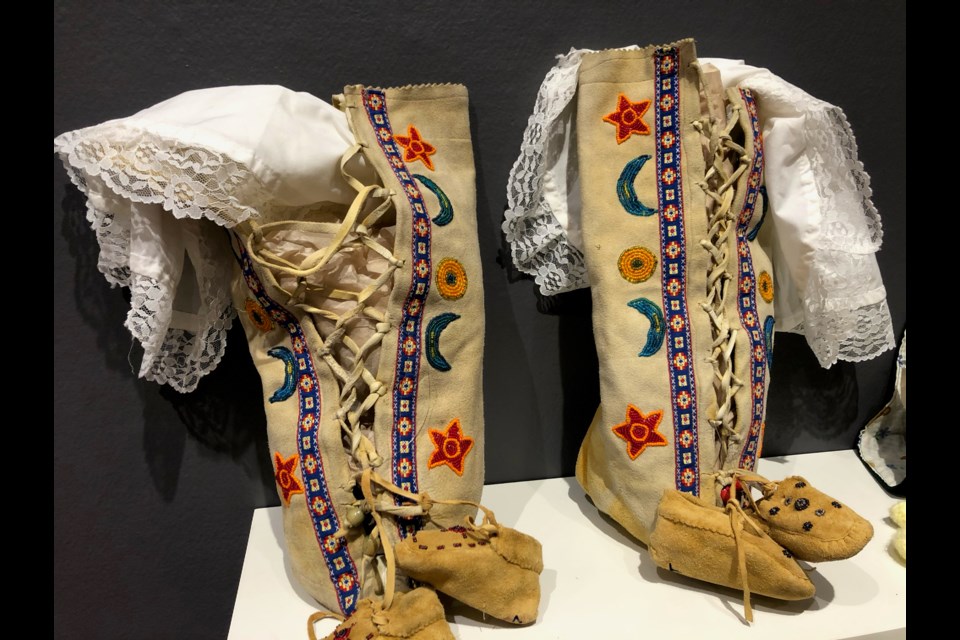Allowing a child to see the world at the eye level of adult members of their community is a moment of grace and connection for Indigenous and non-Indigenous children. Shirley Stevens, along with Caitlyn Bird, have revealed the importance of this with their new exhibit, Dakobinaawaswaan (Baby in a Cradleboard) at the Thunder Bay Art Gallery.
Shirley Stevens, from Opwaaganasiniing, Lake Helen Reserve, began collecting cradleboards after the cradleboard she used for her daughter, Cree Stevens, disappeared from a moving truck. This cradleboard was gifted to Stevens in Biinjitiwaabik Zaaging, Rocky Bay First Nation, and had carried 18 children.
A couple years after this loss Stevens came across one on eBay from a community she had connections to. This began the collection displayed in Dakobinaawaswaan (Baby in a Cradleboard).
Creating and curating
When she began collecting, Stevens observed the loss of this practice and how rare it was becoming, pushing her to discover and find more than 100 cradleboards from the Great Lakes Area and all-over North America.
“[Cradleboards] allow a child to view the world at eye level with other people in their families and communities,” Stevens says, “it teaches the child and, at the same time, protects the child.”
Through her daughter Cree, Stevens met the talented artist and curator Caitlyn Bird, creating a powerful dynamic to make this show come alive.
Being raised in Thunder Bay, and being a cradleboard baby herself, Bird has been specializing in beadwork since she was 16 and says she felt an immediate connection to Stevens and her close friends, the Cradle Keepers.
“The connection to Shirley and the cradle keepers brought a deeper connection to my own history, it was deeply personal on that level,” Bird says.
Revitalizing tradition
Stevens and Bird don’t shy away from their desires for this exhibit.
“This needs to be taken into communities, people need to see their beautiful culture and to feel proud and inspired to make cradles again,” says Bird, who graduated with her BFA in Museum Studies from the Institute of American Indian Arts in Santa Fe, NM.
“My biggest want is that it’s seen by as many people as possible. And I think recognizing that Indigenous people know how to care for their children in the best possible way is an important message because it often gets lost in people’s assumptions and stereotypes and I think it’s important to reinforce that that is the message,” Stevens says.
They both note the importance of relationship and says the heart of this exhibit is the representation of Indigenous families and communities and how the women and children of these communities are important members.
Dakobinaawaswaan (Baby in a Cradleboard) reinforces this importance.
Withstanding time
Both Stevens and Bird plan to take this further than this exhibit and Stevens hopes the younger generation will continue to carry this tradition forward.
While sharing knowledge and wisdom with one another, both Bird and Stevens have recognized how intimate an exhibit like this is, to them and the viewers, and how they’ve both learned more about themselves throughout the process.
“It’s been such an intimate journey,” Stevens says, “and I’ve met so many people all over North America who have been so supportive of this endeavour.”
While both artists have discovered their own histories, they hope viewers, Indigenous and non-Indigenous take time to recognize the historical and communal significance of cradleboards within the space they’ve created.
Dedicated to the late Freda McDonald, beloved elder, and spiritual guide, Dakobinaawaswaan (Baby in a Cradleboard) will be open to the public Saturday and Sunday 12 p.m. – 5 p.m.



